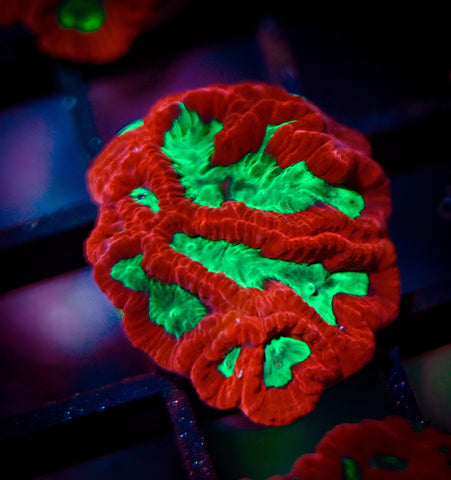PLATYGYRA CORAL CARE OVERVIEW
LIGHT: LOW-MODERATE (75-125 par) is what we find best. It is important to keep in mind that it is far easier to damage coral with too much lighting so in our opinion when it comes to lighting, less is often more for LPS corals. You can learn more about Lighting and it's overall impact on your reef tank in our article Lighting and your Reef Tank
FOOD: We haven't noticed that any special feeding strategies are required for this coral. Like most corals they capture nutrients from the water and will do best when supplied a healthy amount of food. Our method is high import, high export. You can learn more about Feeding and Filtration in our article Feeding, Filtration and your Reef Tank.
FLOW: MODERATE. Platygyra corals benefit from moderate water movement which will be enough to keep the coral clean of any detritus and debris while bringing food to its many polyps. Too much flow, especially direct flow, can cause damage to the corals tissue or an inability to capture food. You can read more about Flow and its overall impact on your reef tank in our article Flow and your Reef Tank
DIFFICULTY: BEGINNER. There are plenty of aquacultured varieties of platygyra available and this tells us that many hobbyists have been able to find long term success. Although a slow grower, the platygyra is often found in striking two tone color combinations and is an encrusting coral. Like with all corals, specimens have been seen to do well in captivity when the right combination of Food/Light/Flow and Filtration are achieved.
PRICE: LOW-MODERATE. Platygyra are moderately priced depending on color and size variety. More basic colored frags tend to be on the low end of pricing while certain color varieties such as pink and highlighter yellow fetch a higher price. As always the specific coloration and size of the specimen will dictate the price.
COLLECTION ZONE: Indo-Pacific
SCIENTIFIC NAME: Platygyra is a genus of stony corals in the family Merulinidae. Platygyra. Platygyra lamellina (Hard brain coral).jpg. Platygyra lamellina.
AGGRESSION: MODERATE. They are not the most aggressive coral but they are equipped with sweepers that will increase in size with the colony. We recommend providing at least 3" space from other species but as always you should monitor it.
NATURAL TEMPERATURE: 82 °F / 28 °C although most corals can adapt and survive in temps as low as 77 degrees and as high as 84 degrees. You can read more about temperature and how it affects your reef tank in our article Temperature and your Reef Tank.
PH: Recommend 8.0-8.4, we tend to run around 8.2-8.3 over 24 hours. You can read more about pH in our article pH and your Reef Tank
NITRATE: 5-10, try to keep stable. You can read more about nitrate and our approach to maintaining it in our article Nutrients and your Reef Tank
PHOSPHATE: 0.05-0.1, try to keep stable. You can read more about Phosphate and our approach to maintaining it in our article Nutrients and your Reef Tank
ALKALINITY: Recommend 8-9 dKh. You can read more about how we maintain our alkalinity in our article Alkalinity, Calcium and your Reef Tank
CALCIUM: Recommend 400-450. You can read more about how we maintain our calcium in our article Alkalinity, Calcium and your Reef Tank
More About Platygyra Corals
Platygyra are large polyp stony (LPS) corals in the Merulinidae family. Also called, “Brain coral,” “Maze coral,” or “Brain Worm coral." Platygyra grow by encrusting and can be found in various shades of greens, purples, grays, and greens with contrasting valleys. They may grow in a domed shape or in a flat plate shape.

Platygyra corals require moderate lighting. We recommend around 100-150 PAR. Bear in mind that most corals can be gradually adapted to lighting conditions outside of their normal preferences. Platygyra corals also prefer moderate water flow.

Through their symbiotic relationship with a photosynthetic algae, known as zooxanthellae, they receive many of their nutrients. To maintain good health, calcium, strontium, and other trace elements should be monitored and added as needed. Platygyra corals may also benefit from targeted feeding of micro-planktons.

When placing your Platygyra, please remember that these corals are semi-aggressive and may attack other corals with their sweeper tentacles. Be sure to provide enough personal space for your Platygyra corals to grow and thrive.
